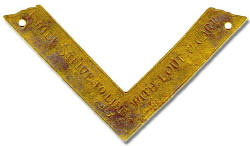En:Baal's Bridge Square: Unterschied zwischen den Versionen
Oberg (Diskussion | Beiträge) KKeine Bearbeitungszusammenfassung |
Oberg (Diskussion | Beiträge) KKeine Bearbeitungszusammenfassung |
||
| Zeile 1: | Zeile 1: | ||
== Baal's Bridge Square == | == Baal's Bridge Square == | ||
Source: masonicwiki.info | Source: masonicwiki.info | ||
[[Datei:Baals Bridge Square small.jpg]] | [[Datei:Baals Bridge Square small.jpg|right]] | ||
Lodge 13 in Limerick, Ireland have in their archives an old brass square that was found under the foundations of Baal's Bridge. This Square dated 1507 is reputed to be one of the earliest Masonic items in the world | Lodge 13 in Limerick, Ireland have in their archives an old brass square that was found under the foundations of Baal's Bridge. This Square dated 1507 is reputed to be one of the earliest Masonic items in the world | ||
Version vom 17. Dezember 2010, 19:36 Uhr
Baal's Bridge Square
Source: masonicwiki.info
Lodge 13 in Limerick, Ireland have in their archives an old brass square that was found under the foundations of Baal's Bridge. This Square dated 1507 is reputed to be one of the earliest Masonic items in the world
The inscription on side 1 is "I will strive to live with love & care" and on side 2 "upon the level and by the square"
The old brass square, known as the Baal’s Bridge Square, was recovered from the foundations of Baal’s Bridge in Limerick when the bridge was being rebuilt in 1830. It is inscribed “I will strive to live with Love and Care Upon the Level By the Square” and bears the date, 1507.
This ancient Square, carefully treasured by Lodge 13 is recorded as being presented to Brother Michael Furnell, Provincial Grand Master, by Brother James Pain, (referred to as the Provincial Grand Architect).
In the Freemasons' Quarterly Review, 1842, p. 288, Bro. Furnell, under the date of 27th. August, 1842, printed a short note on this relic of antiquity, accompanying which is a facsimile sketch. He says that Bro. Pain, in 1830, had been contractor for re-building Baal's Bridge in Limerick, and on taking down the old structure, he discovered under the foundation stone at the English town side, this old brass square, much eaten away. In the facsimile sketch, Bro, Furnell puts the date as 1517, which is a mistake, as the square bears the date 1507. A heart appears in each angle.
In the book by H. F. Berry, Assistant Keeper of the Irish Records, “The Marencourt Cup and Ancient Square.” dated 1905, Bro. Berry records that “Ball's (or Baal's) Bridge is a beautiful structure, of a single arch, built in 1831, to replace an ancient bridge of the same name, which consisted of four arches, with a range of houses on its west side. The date of the erection of this ancient structure has not been ascertained, but possibly the old square, dated 1507, may have been placed, under the foundation stone in that year. In any case, Bro. Furnell informs us that the old bridge is mentioned in records of 1558.
In a most interesting and valuable paper on a " Diary of the Siege of Limerick Castle, 1642," Journal, R.S.A.I., 1904, p. 163, Mr. M. J. McEnery, M.R.I.A., reproduces a facsimile of a Map of Limerick, taken from Speed's Map of Munster, 1610, which shows the old bridge, called in the reference the Thye bridge ; also portion of the city of Limerick, cir. 1590, from Mr. T. J. Westropp's copy of a map of Limerick in the Library, Trinity College, Dublin, wherein the same bridge is shown, and called in the reference the Tide bridge.
James Pain, a distinguished architect, was born at Isleworth in 1779. He and his brother, George R, Pain, entered into partnership, subsequently settling in Ireland, where James resided in Limerick and George in Cork. They designed and built a number of churches and glebe houses. Mitchelstown Castle, the magnificent seat of the Earls of Kingston, was the largest and best of their designs. They were also architects of Cork Court-house and the County Gaol, both very striking erections, and of Dromoland Castle, the seat of Lord Inchiquin. James Pain died in Limerick 13th. December, 1877, in his 98th year, and was buried in the cathedral church of St. Mary in that city.”

